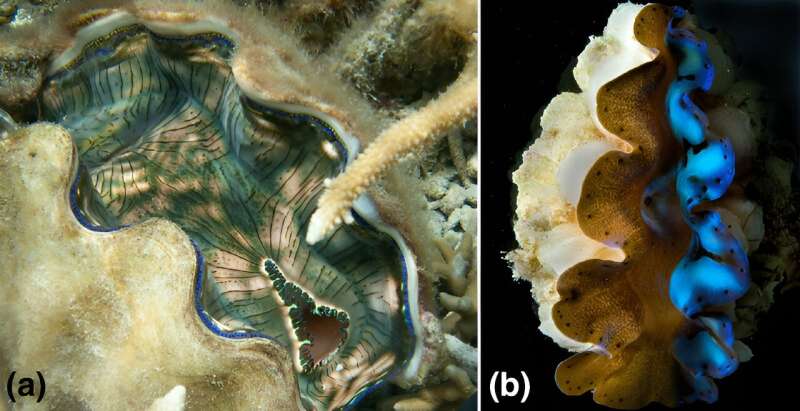This article has been reviewed according to Science X's editorial process and policies. Editors have highlighted the following attributes while ensuring the content's credibility:
fact-checked
peer-reviewed publication
trusted source
proofread
Giant clams may hold the answers to making solar energy more efficient

Solar panel and biorefinery designers could learn a thing or two from iridescent giant clams living near tropical coral reefs, according to a new Yale-led study.
This is because giant clams have precise geometries—dynamic, vertical columns of photosynthetic receptors covered by a thin, light-scattering layer—that may just make them the most efficient solar energy systems on Earth.
"It's counter-intuitive to a lot of people, because clams operate in intense sunlight, but actually they're really dark on the inside," said Alison Sweeney, associate professor of physics and of ecology and evolutionary biology in Yale's Faculty of Arts and Sciences. "The truth is that clams are more efficient at solar energy conversion than any existing solar panel technology."
In the new study, published in the journal PRX Energy, a research team led by Sweeney presents an analytical model for determining the maximum efficiency of photosynthetic systems based on the geometry, movement, and light-scattering characteristics of giant clams.
It is the latest in a series of research studies from Sweeney's lab that highlight biological mechanisms from the natural world that could inspire new sustainable materials and designs.
In this case, the researchers looked specifically at the impressive solar energy potential of iridescence giant clams in the shallow waters of Palau in the Western Pacific.
The clams are photosymbiotic, with vertical cylinders of single-celled algae growing on their surface. The algae absorb sunlight—after the light has been scattered by a layer of cells called iridocytes.
Both the geometry of the algae and the light scattering of the iridocytes are important, the researchers say. The algae's arrangement in vertical columns—which makes them parallel to the incoming light—enables the algae to absorb sunlight at the most efficient rate. This is because the sunlight has been filtered and scattered by the layer of iridocytes, and the light then wraps uniformly around each vertical algae cylinder.
Based on the giant clams' geometry, Sweeney and her colleagues developed a model to calculate quantum efficiency—the ability to convert photons into electrons. The researchers also factored in fluctuations in sunlight, based on a typical day in the tropics with a sunrise, midday sun intensity, and sunset. The quantum efficiency was 42%.
But then the researchers added a new wrinkle: the way giant clams stretch themselves in reaction to changes in sunlight. "Clams like to move and groove throughout the day," Sweeney said. "This stretching moves the vertical columns farther apart, effectively making them shorter and wider."
With this new information, the clam model's quantum efficiency jumped to 67%. By comparison, Sweeney said, a green leaf system's quantum efficiency in a tropical environment is only about 14%.
An intriguing comparison, according to the study, would be northern spruce forests. The researchers said boreal spruce forests, surrounded by fluctuating layers of fog and clouds, share similar geometries and light-scattering mechanisms with giant clams, but on a much larger scale. And their quantum efficiency is nearly identical.
"One lesson from this is how important it is to consider biodiversity, writ large," Sweeney said. "My colleagues and I continue to brainstorm about where else on Earth this level of solar efficiency might happen. It is also important to recognize we can only study biodiversity in places where it is maintained."
She added, "We owe a major debt to Palauans, who put vital cultural value on their clams and reefs and work to keep them in pristine health."
Such examples may offer inspiration and insights for more efficient sustainable energy technology.
"One could envision a new generation of solar panels that grow algae, or inexpensive plastic solar panels that are made out of a stretchy material," Sweeney said.
More information: Amanda L. Holt et al, Simple Mechanism for Optimal Light-Use Efficiency of Photosynthesis Inspired by Giant Clams, PRX Energy (2024). DOI: 10.1103/PRXEnergy.3.023014
Journal information: PRX Energy
Provided by Yale University





















